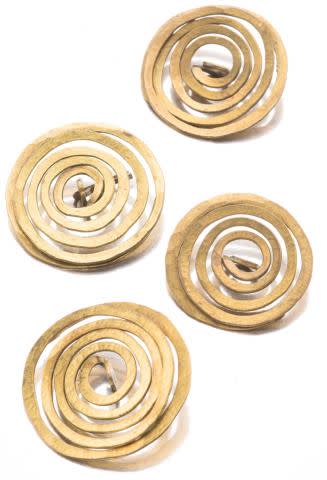Elsa Schiaparelli
Jacker with Vegetable Buttons, 1941
Chanel Buttons
By Maison Desrues
The history of the button is largely the history of fashion. What began as a functional detail for menswear in the 13th century, when buttonholes first appeared on clothing, has since taken on many forms as both a practical design element and an ornamental feature. After migrating to women’s wear in the early 19th century, buttons have played an important role in the appearance and functionality of garments for both sexes. Often overlooked but never forgotten, these tiny circular ornaments are rich in history through both the purpose they serve and the various identities they have adapted.
In the publication “Shots of Style: Great Fashion Photographs”, British photographer David Bailey recalls Andy Warhol once saying, “I wonder what happens to all the people who make the buttons”. Button-makers can go on to create miniature empires, case in point: costume jewelry designer and button craftsman, George Desrues. Born as a company in 1929, Maison Desrues began working with the most prestigious designers of the early twentieth century, hand crafting intricate buttons for haute couture garments by the likes of Dior, Chanel and Lanvin. In 1965, Georges Desrues produced his first collection of buttons for Mademoiselle Coco Chanel and quickly became the house’s preferred supplier. In 1984, Chanel purchased Monsieur Desrues’ business and the house’s namesake founder, who once employed 400 craftsmen, remained working until his death in 1992. Not a bad acquisition for a brand who famously never repeats a buttons; yes, Chanel designs entirely new buttons each season in the spirit of their upcoming collection.

Chanel Buttons
By Maison Desrues
A few decades after Georges Desrues broke onto the scene, Paco Rabanne, having trained as an architect, began his career in fashion making plastic buttons and jewelry for Parisian couture houses. The Spanish designer soon founded his own house in the 1960s and quickly became known as the enfant terrible of the French fashion world for his use of unconventional materials, such as metal and plastic, in his garments. A number of Rabanne’s designs even pay homage to his history as a button-maker, particularly his disk-shaped, tiled dresses and his trademark metal accessories, which appear at first glace to be a mirage of buttons carefully attached by metal links.

Paco Rabanne Handbag
In 1997, upon his appointment as creative director of Hermès, Martin Margiela aimed to reinvigorate the historic brand. Margiela rid the French house of all visible branding elements, such as costly engraved buttons, and devised a fresh logo for the brand. The designer developed a new type of button, often made of horn or wood, with six holes as opposed to the traditional four. The extra two spaces allowed for the thread to form a subtle ‘H’ in the center of the button, while being fastened to a garment. With this invention came a subtle new logo that lived inside each and every Hermès button. Margiela’s affinity for buttons was also expressed in his namesake brand’s spring/summer 2012 artisanal collection, when the fashion house sent a button-covered suit down the runway, with thousands of pearlescent disks in place of fabric.
Hermès Buttons
Designed by Martin Margiela
Maison Martin Margiela Spring/Summer 2012 Artisanal
Button Suit
Decades before Martin Margiela took the reigns at Hermès and well before Paco Rabanne began his career making buttons, Elsa Schiaparelli built a successful fashion house where novelty buttons were a trademark of her intricate couture ensembles. In the latter half of the 1930s, everything from hand-painted birds and butterflies, to pianos, drums and vegetables passed through the buttonholes of her ornate designs. There was strong attention paid to bugs in her ‘Pagan’ Collection from 1938, while that same year Schiaparelli’s ‘Circus’ collection included cast-metal acrobats and circus horses riding down to the front of silk jackets; all archetypal examples of her surrealist design sensibility.
Elsa Schiaparelli
Jacket with Butterfly Buttons, 1937
Elsa Schiaparelli
Jacket with Bird Buttons
Elsa Schiaparelli
Jacket with Acrobat Buttons, Circus Collection, 1938
Elsa Schiaparelli
Jacket with Horse Buttons, Circus Collection, 1938
Elsa Schiaparelli
Jacket with Bug Buttons, Pagan Collection, 1938
Elsa Schiaparelli
Jacket with Piano Buttons, 1939
Elsa Schiaparelli
Jacket with Vegetable Buttons, 1941
The Italian designer also worked closely with artists to develop unique button designs. In 1935 sculptor Alberto Giacometti created a set of guilt bronze buttons for Schiaparelli and in 1940 designer François Victor Hugo crafted a pink and metallic ceramic version of Giacometti’s design. Schiaparelli and Hugo continued to collaborate on a number of button designs through 1945.

Alberto Giacometti for Schiaparelli, 1935
Over a century before Giacometti and Schiaparelli began collaborating, French Rococo painter Jean-Honoré Fragonard created miniature, round paintings which became one of the foremost examples of artist-made buttons, while in 1925 French-Ukrainian artist Sonia Delaunay was producing wooden buttons with geometric motifs and artist Maurice de Vlaminck was experimenting in painting buttons.
Jean-Honoré Fragonard
Painted Button, 18th Century
Sonia Delaunay
Wood Button Painted with Geometric Motif, 1925/30
Maurice de Vlaminck
Painted Button, 1925
While American sculptor Alexander Calder may be most widely known for his suspended and standing mobiles, the artist also produced over one thousand pieces of unique jewelry throughout his career, as well as a few individual sets of detachable brass buttons that could fasten onto jackets.
Alexander Calder
Buttons

Alexander Calder
Buttons

Alexander Calder
Buttons

Alexander Calder
Buttons
Although there is far less attention being paid by contemporary artists to crafting these miniature, utilitarian sculptures, buttons have found their way into fine art, particualry within the work of artist Mike Kelley's Memory Ware Flats.
What started as a small ornamental feature in fashion has grown into a category all its own. From designers to visual artists, everyone loves a small detail, and what better detail than a button?


